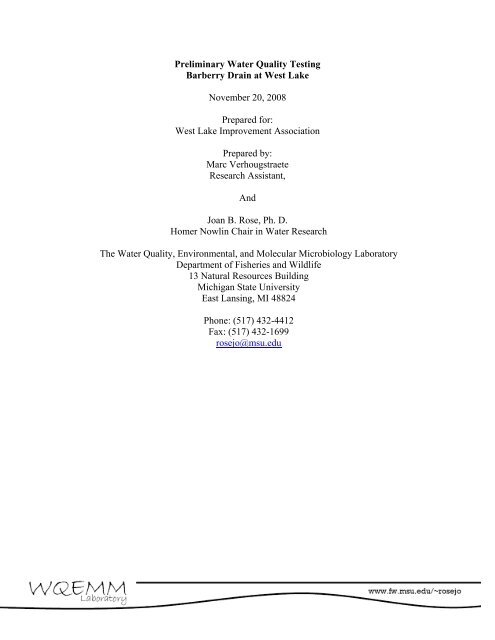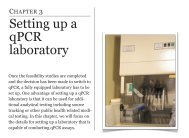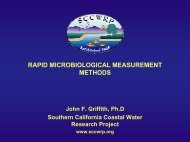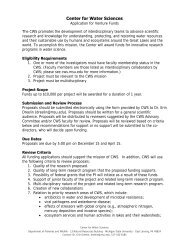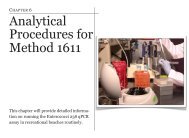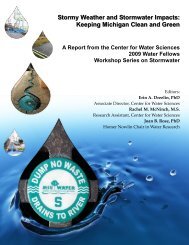West Lake Improvement Association - MSU Center for Water Sciences
West Lake Improvement Association - MSU Center for Water Sciences
West Lake Improvement Association - MSU Center for Water Sciences
- No tags were found...
You also want an ePaper? Increase the reach of your titles
YUMPU automatically turns print PDFs into web optimized ePapers that Google loves.
Preliminary <strong>Water</strong> Quality TestingBarberry Drain at <strong>West</strong> <strong>Lake</strong>November 20, 2008Prepared <strong>for</strong>:<strong>West</strong> <strong>Lake</strong> <strong>Improvement</strong> <strong>Association</strong>Prepared by:Marc VerhougstraeteResearch Assistant,AndJoan B. Rose, Ph. D.Homer Nowlin Chair in <strong>Water</strong> ResearchThe <strong>Water</strong> Quality, Environmental, and Molecular Microbiology LaboratoryDepartment of Fisheries and Wildlife13 Natural Resources BuildingMichigan State UniversityEast Lansing, MI 48824Phone: (517) 432-4412Fax: (517) 432-1699rosejo@msu.edu
SUMMARYFecal indicator bacteria are used to assess the water quality throughout the United States butthese bacteria lack specificity <strong>for</strong> determining origin of contamination. <strong>West</strong> <strong>Lake</strong>, located inPortage, Michigan, detected elevated E. coli levels at Fabercrest Drain. The <strong>West</strong> <strong>Lake</strong><strong>Improvement</strong> <strong>Association</strong> asked the <strong>Water</strong> Quality and Environmental Microbiology Laboratoryof Michigan State University to further investigate the sources of the high levels of E. coli. <strong>MSU</strong>used multiple tools to assay the water including traditional fecal indicators (E. coli andEnterococci) as well as emerging fecal indicators (Clostridium perfringens and coliphage) andmicrobial source tracking markers (Enterococci surface protein and Bacteroides). Three sampleswere collected from the <strong>West</strong> <strong>Lake</strong> Drain and high levels of traditional and emerging fecalindicators were detected. The human Bacteroides marker was detected in each sample. Thispreliminary sampling ef<strong>for</strong>t would indicate the presence of human fecal pollution.INTRODUCTION<strong>West</strong> <strong>Lake</strong> is a natural lake of about 326 acres. A storm drain leading from a nearby subdivision(Fabercrest neighborhood) drains the approximately 137 house subdivision and empties into theBarberry Drain. Figures 1 through 3 give varying degrees of detail of <strong>West</strong> <strong>Lake</strong> and thesurrounding area. Figure 3 shows the Barberry Drain on the northwest corner of <strong>West</strong> <strong>Lake</strong> andthe Fabercrest neighborhood directly north of the drain. <strong>Water</strong> quality concerns arose from asingle sample taken from the drain that exceed Michigan’s E. coli total body contact standards of300 colony <strong>for</strong>ming units/ 100 ml. The <strong>West</strong> <strong>Lake</strong> <strong>Improvement</strong> <strong>Association</strong> (WLIA) requestedthe <strong>Water</strong> Quality and Environmental Microbiology Laboratory of Michigan State University toinvestigate potential sources of fecal pollution to the lake. <strong>Water</strong> samples were collected onBarberry Drain of <strong>West</strong> <strong>Lake</strong> in Portage, Michigan. Three samples from one location werecollected and analyzed <strong>for</strong> fecal indicators (E. coli, Enterococci, coliphage, and Clostridiumperfringens) and <strong>for</strong> source tracking markers (Enterococci esp and Bacteroides human and cowmarkers).Bacterial indicators, such as Escherichia coli (E. coli), enterococci, and fecal coli<strong>for</strong>m, arecurrently used throughout the US and world as assessors of potential illnesses associated withwater use and pollution. Fecal water quality indicators are based on the premise that each will befound consistently in fecal waste, e.g. sewage or manure, and have similar survival and transportproperties as the pathogen known to cause disease (Col<strong>for</strong>d 2007). Thus indicators should becorrelated to the presence of the pathogen. However, survival rates and regrowth potential ofsome bacteria varies depending on water temperature, sunlight, nutrient status, and turbidity(McLellan 2007) and bacterial indicators have been poor predictors <strong>for</strong> the presence of virusesand parasites. In addition, the indicators have not been able to identify the source of thecontamination.Table 1 describes the indicators and their application. All of the indicators used by the <strong>MSU</strong>laboratory are found in the feces of humans or animals and are referred to as fecal indicators.2
METHODSThe <strong>Water</strong> Quality and Environmental Microbiology Laboratory of Michigan State Universityapplied a multifaceted approach to investigating The Barberry Drain of <strong>West</strong> <strong>Lake</strong>. Thisapproach involved looking at fecal pollution indicators (E. coli, enterococci, Clostridiumperfringens, coliphage), molecular source tracking markers (Bacteroides and Enterococci espgene), and physical data (precipitation, pH, turbidity, etc.). All of these resources were thencompared to draw conclusions on potential impacts associated with the watershed.Sample Collection:One sampling location was chosen on <strong>West</strong> <strong>Lake</strong> (Table 2) because of past water qualitystandard exceedances. Three samples were collected <strong>for</strong> this project: one during a period of dryweather, one two hours into a rain event, and one 4 hours into a rain event. The precipitation datawere collected from a local on-line weather station (Weather Underground 2008). Other datacollected at the time of sampling include air temperature, wind speed and direction, turbidity,pH, and general weather conditions.Grab samples were obtained via boat at the Barberry Drain outlet to <strong>West</strong> <strong>Lake</strong> using sterilesample bottles. Samples were placed on ice and transported to a location where <strong>MSU</strong> studentsmeet and transported the samples to the <strong>MSU</strong> <strong>Water</strong> Quality and Health laboratory <strong>for</strong> analysis.The samples were kept at 4 o C until processing on the same day as collection.Table 2. Sampling sites and ID<strong>Water</strong>Location<strong>Water</strong>bodySample IDDescriptionBarberry Drain <strong>West</strong> <strong>Lake</strong> North-west cornerof <strong>West</strong> <strong>Lake</strong>42.1929, -85.5832DatesCollected6/26/20088/22/20089/08/2008Bacterial analysisSamples were analyzed <strong>for</strong> E. coli using mTEC membrane filtration method (American PublicHealth <strong>Association</strong> 1998, US EPA. 2005). Enterococci were analyzed using membrane filtrationaccording to USEPA Method 1600 (Enterococci) (US EPA. 2002). Clostridium perfringens wereanalyzed using membrane filtration and mCP agar (EPA 1995, Bisson 1979). Coliphage wereanalyzed via a modification of USEPA Methods 1601 and 1602 (US EPA 2001). Table 3includes the media and incubation conditions used <strong>for</strong> these indicators. Volumes <strong>for</strong>bacteriological analysis via membrane filtration ranged from .1 ml to 100ml.5
Table 3. Media and Methods used <strong>for</strong> Microbial Indicator TestingTest Media Incubation ReferenceE. coli mTEC 24-28 hours at APHA Standard Method37°C9223B (American PublicHealth <strong>Association</strong> 1998,US EPA. 2005)Enterococci mEI agar 24 hours at 41°C USEPA Method 1600 (USEPA. (2002)Clostridium mCP 24 hours at 45°C EPA 1995, Bisson 1979perfringensColiphage Tryptic SoyAgar16 – 24 hours at37°CUSEPA Method1601/1602 (US EPA2001)Coliphage AnalysisAgar overlays were utilized to detect coliphage present in the samples. Non-filtered watersamples were used to enumerate coliphage. Two types of overlays were conducted one using E.coli F + amp as a host, the other using E. coli CN-13. The F + amp is known as male specificcoliphage and it infects the host at the F-pili. Somatic coliphage (CN-13) infect the host bacteriaat the outer cell wall.One-half ml of host (CN-13 or F + amp) and 2 ml of sample were added to melted top agar be<strong>for</strong>emixing and pouring onto a tryptic soy agar plate (TSA). Coliphage samples were analyzed usingat total of 10 ml of sample per host (5 plates with 2 ml of undiluted sample). Thus, 20 ml ofsample per site were assayed <strong>for</strong> coliphage during each sampling event. Two negative controlplates were made, one with each host, by adding 1.5 ml host to the top agar, mixing and pouringonto a TSA plate. A positive control was run <strong>for</strong> each host type by adding 1.5 ml host to the topagar, mixing and pouring onto a TSA plate. Stock phage was then spotted onto the hardeningagar layer. Overlays were incubated at 37°C <strong>for</strong> 24 hours, and then assessed <strong>for</strong> plaque<strong>for</strong>mation.Molecular AnalysisBacteroidesTwo liters of water were centrifuged <strong>for</strong> 30 minutes at 4000 rpm. Mobio mega soil DNA kit wasused to extract the DNA from the pellet. PCR amplification was per<strong>for</strong>med on the extractedDNA. Primers <strong>for</strong> both human and cow Bacteroides sequences were used (Bernhard 2000). Gelelectrophoresis was per<strong>for</strong>med on the PCR product and run on a 1.2% w/v agarose gel at 95 V<strong>for</strong> approximately one hour.Enterococci esp MarkerThe enterococci bacteria which grew up on the membrane filter as assayed above were washedoff the membrane and extracted (Kumar, L. 2007, Scott 2005). The primers specific <strong>for</strong> the espgene in E. faecium previously developed and examined <strong>for</strong> specificity to human fecal pollutionwere used in a polymerase chain reaction [PCR] (Scott 2005). The <strong>for</strong>ward primer: (5’-TATGAA AGC AAC AGC ACA AGT-3’) and the conserved reverse primer (5’ –ACG TCG AAA6
GTT CGA TTT CC-3’) were used <strong>for</strong> all reactions. Gel electrophoresis was per<strong>for</strong>med on thePCR product and run on a 1.2% w/v agarose gel at 95 V <strong>for</strong> approximately one hour.RESULTSThree samples were analyzed <strong>for</strong> fecal indicators and microbial source tracking markers. Thesample taken on 6/26/2008 was taken when a total of .13 inches of rain had fallen in the previous24 hours and prior to that no rain was recorded in the previous nine days (6/15/2008). Thesecond sample was taken on 8/22/2008 approximately two hours into a precipitation event (1:00PM-total rainfall was .49 inches). The third sample was collected on 9/8/2008, approximatelyfour hours after rainfall began to fall (6:00 PM- total rainfall was 1.14 inches).Fecal pollution indicatorsEach sample was analyzed using E. coli, enterococci, C. perfringens, and coliphage as the fecalpollution indicators. According to the analysis per<strong>for</strong>med by our laboratory, there were highlevels of fecal bacteria present during each of the three sampling events. The arithmetic averageE. coli, Enterococci, and Clostridium perfringens results were 7069, 9422, and 761 (colony<strong>for</strong>ming units/100 mL), respectively. The bacterial results are summarized in table 4.Molecular resultsIn addition to bacterial indicator, each sample was analyzed <strong>for</strong> Bacteroides and the Enterococciesp gene. The Bacteroides results tested positive <strong>for</strong> the human Bacteroides during each of thethree sampling events. No bovine Bacteroides were detected in any of the samples.The Enterococci surface protein (esp) gene, which is specific to human sewage, was also testedin each sample. There were no positive detections of the esp gene. The molecular results aresummarized in table 4.Table 4: <strong>Water</strong> quality results summary of <strong>West</strong> <strong>Lake</strong>6/26/2008 8/22/2008 9/8/2008E. coli 8266.67 3733 9208Enterococci 9969 12017 6283C. perfringes 668 195 1420Coliphage (F amp) 30 NT >.1Coliphage (CN-13) 485 NT 260Bacteroides Human + + +Bacteroides Bovine - - -Enterococci esp - - -NT: not testedDISCUSSIONThe <strong>Water</strong> Quality and Environmental Microbiology Laboratory used a multifaceted approach tothe Barberry Drain of <strong>West</strong> <strong>Lake</strong>. The three samples taken were analyzed <strong>for</strong> fecal pollutionindicator bacteria and <strong>for</strong> microbial source tracking methods. The sample set collect is not largeenough to run statistical analysis or to find any normality in the results. Each sample hadelevated E. coli and Enterococci levels that far exceeded Michigan Department of Environmental7
Quality total body contact standards <strong>for</strong> recreational water (300 E. coli/100 ml and 61Enterococci/100 ml). The coliphage data suggests that there was a fresh/consistent source offecal pollution because it is unable to regrow in the environment and it has a limited life. This isfurther suggested by the detection of the human Bacteroides in each sample.Due to the small sample size, correlations between fecal indicators/molecular source trackingmarkers and the physical parameters could not be calculated. The data <strong>for</strong> physical parametersand water quality results are summarized in appendix 1. The raw data <strong>for</strong> Bacteroides can befound in appendix 2.Further investigation and sampling at <strong>West</strong> <strong>Lake</strong> are required in order to:• Make a definitive conclusion of the risk posed to human health from exposure to water• To draw statistically significant conclusions on the sources of fecal contamination and,• Identify how physical parameters impact the transport of bacteria from surrounding areas to<strong>West</strong> <strong>Lake</strong>8
REFERENCESAmerican Public Health <strong>Association</strong>, American <strong>Water</strong> Works <strong>Association</strong>, and <strong>Water</strong>Environment Federation. (1998). Standard methods <strong>for</strong> the examination of water and wasterwater 19 th Ed. Section 9223.Bernhard, A.E. and K.G. Field. 2000. A PCR assay todiscriminate human and ruminant feces on the basis of host differences inBacteroides–Prevotella genes encoding 16S rRNA, Appl. Environ. Microbiol.66: 4571–4574.Bisson, J.W. and V.J. Cabelli. (1979). Membrane filter enumeration method <strong>for</strong> Clostridiumperfringens. Applied and Environmental Microbiology 37: 55-66.Col<strong>for</strong>d, John M Jr., T.J. Wade, K.C. Schiff, C.C. Wright, J.F. Griffith, S.K. Sandhu, S. Burns, .Sobsey, G. Lovelace, and S.B. Weisberg. (2007). <strong>Water</strong> quality indicators and the risk of illnessat beaches with nonpoint sources of fecal contamination. Epidemiology 18: 27-35.Kumar, L. 2007. Development Of A Rapid Method For A Human Pollution Source TrackingMarker Using Enterococcus Surface Protein (Esp) In E. Faecium A THESIS Submitted toMichigan State University, in partial fulfillment of the requirements <strong>for</strong> the degree of MASTEROF SCIENCE Department of Fisheries and Wildlife, E. Lansing MI.McLellan, Sandra L., E.J. Hollis, M.M. Depas, M. Van Dyke, J. Harris, and C.O. Scopel. (2007).Distribution and fate of Escherichia coli in <strong>Lake</strong> Michigan following contamination with urbanstormwater and combined sewer overflows. Journal of Great <strong>Lake</strong>s Research 33:566-580.Schwab, Kellogg J. (2007). Are existing bacterial indicators adequate <strong>for</strong> determining recreationwater illness in water impacted by nonpoint pollution?. Epidemiology 18: 21-22.Scott, Troy M., J.B. Rose, T.M. Jenkins, S.R. Farrah, and J. Lukasik. (2002). Microbial sourcetracking: Current methodology and future directions. Applied and Environ. Microbiology 68:5796-5803.Scott, T. M., Jenkins, T.M., Lukasik, J and Rose, JB 2005. Potential Use of a Host AssociatedMolecular Marker in Enterococcus faecium as an Index of Human Fecal Pollution.Environmental Science & Technology 39: (1) 283 – 287.United States EPA. (1995). Method <strong>for</strong> detection and enumeration of Clostridium perfringens inwater and sediments by membrane filtration. EPA/600/R-95/030/ Office of Research andDevelopment, Washington D.C.United State EPA. (2005). Method 1603: Escherichia coli (E. coli) in water by membranefiltration using modified membrane-Thermotolerant Escherichia coli agar (modified mTEC).EPA 821-R-04-025. Office of <strong>Water</strong>, Washing D.C.9
United States EPA. (2002). Method 1600: Enterococci in water by membrane filtration usingmembrane-Enterococcus indoxyl-b-D-Glucoside agar (mEI). EPA-821-R-02-022. Office of<strong>Water</strong>, Washington D.C.United States EPA. (2001). Method 1601: Male specific (F+) and somatic coliphage in water bytwo-step enrichment procedure. EPA 821-R-01-030.United States EPA. (2001). Method 1602: Male specific (F+) and somatic coliphage in water bysingle agar layer (SAL) procedure. EPA 821-R-01-029.The Weather Underground Inc. Retrieved 9/8/2008 from http://www.wunderground.com/cgibin/findweather/getForecast?query=4900.10
Figure 1: Austin <strong>Lake</strong>, <strong>West</strong> <strong>Lake</strong>, and the surrounding areaFigure 2: Detailed map of <strong>West</strong> <strong>Lake</strong> community11
Sampling locationFigure 3: Barberry Drain and Farbercrest Subdivision directly north of drainAppendix 1. Summary of microbiology data and physical parameters6/26/2008 8/22/2008 9/8/2008E. coli (cfu/100 ml) 8266.67 3733 9208Enterococci (cfu/100 ml) 9969 12017 6283C. perfringens (cfu/100 ml) 668 195 1420Coliphage (F amp) (pfu/100ml) 30 NT
Appendix 2: Bacteroides data summarySampling Date6/26/20088/22/20089/8/2008Sample IDSampletypeVolumefiltered (l)Concentratedvolume (ml)Volume used<strong>for</strong> extraction(ml)Extracted DNAvolume (μl)Human MarkerBovineMarker<strong>West</strong> <strong>Lake</strong>-Drain <strong>Water</strong> 2 5 3 200 +,+,+ -,-,-<strong>West</strong> <strong>Lake</strong>-Drain <strong>Water</strong> 2 5 3 200 +,+,- -,-,-<strong>West</strong> <strong>Lake</strong>-Drain <strong>Water</strong> 2 5 3 200 +,+,- -,-,-13


